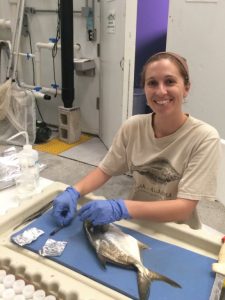Study Assesses Fish Otoliths for Metal Exposure after Deepwater Horizon
– MAY 4, 2018
Researchers examined metal exposure patterns in otoliths from six offshore fish species with varying health status to identify changes corresponding with the Deepwater Horizon incident. Many fish with external lesions exhibited elevated concentrations of nickel and zinc before, during, and after the spill. These findings suggest that lesioned fish had long-term exposure to a persistent source of trace metals in the Gulf of Mexico, which may have had health implications during and after the spill. This study is the first to use the time-keeping properties of fish otoliths for baseline and post-spill comparisons of metal concentrations. The researchers published their findings in Marine Pollution Bulletin: Associations between metal exposure and lesion formation in offshore Gulf of Mexico fishes collected after the Deepwater Horizon oil spill.
Previous studies that detected oil exposure biomarkers in several fish species collected near the spill site documented an elevated prevalence of external skin lesions and hydrocarbon concentrations, suggesting exposure from an episodic event. However, a lack of baseline data and the rapid metabolization of hydrocarbons (and, therefore, biomarkers) made it difficult to connect the spill and sublethal effects on fish. The researchers in this study used otoliths, which are metabolically inert stones located within fish’s teleost ears that incorporate trace elements from surrounding water and diet, to serve as oil biomarkers that would not degrade over time.
Researchers analyzed otolith sections from 222 fish collected near the spill site (Louisiana Shelf and Desoto Canyon) and the West Florida Shelf during 2011 – 2013. Their collections specifically included Red Grouper, Red Porgy, Red Snapper, Southern Hake, Tilefish, and Yellowedge Grouper because these fish have overlapping distributions with the spill site and diverse life history patterns. The team used a inductively coupled plasma-mass spectrometer to identify metal isotopes and assess annual (2009 – 2011) microchemistry for metal concentration changes concurrent with the spill.
Otoliths from all species showed a consistent pattern of short- and long-term metal exposure that varied according to species-specific life history patterns. There was long-term exposure for at least half of the offshore fishes to nickel, zinc, copper, and vanadium before, during, and after the spill. Three distinct groups emerged within most species – those with comparatively low metal concentrations, relatively high copper concentrations, and relatively high nickel and zinc concentrations. The copper group was relatively small compared to the other groups and exhibited no patterns in location, sex, or other metrics that would explain the copper concentration levels. The nickel-zinc group exhibited a much higher number of lesioned fish than anticipated, suggesting a possible greater bioavailability of nickel and zinc resulting from the spill.
The team suspects that lesioned fish may have been immunosuppressed before the spill (nickel and zinc can alter immunoregulatory functions) making them vulnerable to polycyclic aromatic hydrocarbon impacts. Several metals appeared in higher concentrations in fish living near oil platforms and associated with oil production processes (drilling mud, pipelines). Other quantifiable metal sources include natural oil seeps, oil combustion byproducts, transportation activities, and oil and gas extraction activities.
However, there are many additional potential sources for these metals – atmospheric deposition, river discharge, inputs from sediments near highly populated areas, industrial or military installations, agricultural watersheds, and the Mississippi River. The researchers suggest that the elevated concentrations may have resulted from or been bolstered by the 2010 Mississippi River diversion and sediment burrowing or manipulating by the study’s deeper-dwelling species.
Data are publicly available through the Gulf of Mexico Research Initiative Information & Data Cooperative (GRIIDC) at doi:10.7266/N7XS5SFZ and doi:10.7266/N79021PB.
The study’s authors are Jennifer E. Granneman, David L. Jones, and Ernst B. Peebles.
************
This research was made possible in part by a grant from the Gulf of Mexico Research Initiative (GoMRI) to the Center for the Integrated Modeling and Analysis of Gulf Ecosystems II (C-IMAGE II). Other funding sources included the National Fisheries Institute and the State of Louisiana (S203-4S-2121).
The Gulf of Mexico Research Initiative (GoMRI) is a 10-year independent research program established to study the effect, and the potential associated impact, of hydrocarbon releases on the environment and public health, as well as to develop improved spill mitigation, oil detection, characterization and remediation technologies. An independent and academic 20-member Research Board makes the funding and research direction decisions to ensure the intellectual quality, effectiveness and academic independence of the GoMRI research. All research data, findings and publications will be made publicly available. The program was established through a $500 million financial commitment from BP. For more information, visit https://gulfresearchinitiative.org/.
© Copyright 2010-2018 Gulf of Mexico Research Initiative (GoMRI) – All Rights Reserved. Redistribution is encouraged with acknowledgement to the Gulf of Mexico Research Initiative (GoMRI). Please credit images and/or videos as done in each article. Questions? Contact web-content editor Nilde “Maggie” Dannreuther, Northern Gulf Institute, Mississippi State University (maggied@ngi.msstate.edu).






